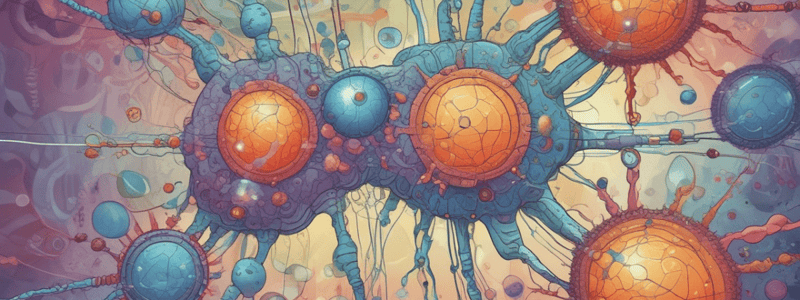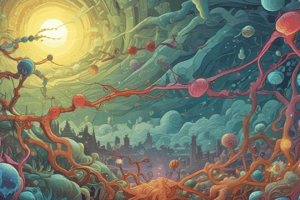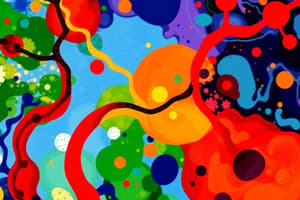Podcast
Questions and Answers
What is the result of increased stress on a cell?
What is the result of increased stress on a cell?
- Irreversible injury (correct)
- Reversible injury
- Cell growth
- Cell adaptation
What type of signalling molecules can diffuse directly into the cell cytoplasm?
What type of signalling molecules can diffuse directly into the cell cytoplasm?
- Hormones
- Hydrophobic signal molecules (correct)
- Local mediators
- Cytokines
What is the function of receptors in cellular signalling?
What is the function of receptors in cellular signalling?
- To respond to environmental stimuli
- To transmit signals to other cells
- To produce signalling molecules
- To convert signals from one physical form to another (correct)
What is an example of a local mediator that plays a role in cellular growth and differentiation?
What is an example of a local mediator that plays a role in cellular growth and differentiation?
How do cells in a multicellular organism primarily communicate with each other?
How do cells in a multicellular organism primarily communicate with each other?
Which type of receptor is primarily involved in neural signalling?
Which type of receptor is primarily involved in neural signalling?
What is the primary function of the cell cycle control system?
What is the primary function of the cell cycle control system?
Which type of cells are capable of continuous division throughout an organism's lifetime?
Which type of cells are capable of continuous division throughout an organism's lifetime?
What is the primary function of growth factors in cell signalling?
What is the primary function of growth factors in cell signalling?
During which phase of the cell cycle does DNA replication occur?
During which phase of the cell cycle does DNA replication occur?
What is the primary difference between hypertrophy and hyperplasia?
What is the primary difference between hypertrophy and hyperplasia?
Which of the following is an example of pathological hyperplasia?
Which of the following is an example of pathological hyperplasia?
What is the most common cause of atrophy?
What is the most common cause of atrophy?
Which of the following is an example of metaplasia?
Which of the following is an example of metaplasia?
What is the result of compensatory hypertrophy in the kidney?
What is the result of compensatory hypertrophy in the kidney?
Flashcards are hidden until you start studying
Study Notes
Cellular Adaptation
- Cellular adaptation occurs when cells respond to increased workload or stress, leading to reversible or irreversible injury.
Control of Cell Growth
- Cells communicate through chemical signals, hormones, and local mediators.
- Hormones act over a long range, while local mediators are secreted into the local environment.
- Some cells communicate through direct cell-cell contact.
- Cells are stimulated when extracellular signaling molecules bind to a receptor, which recognizes a specific protein (ligand).
- Receptors act as transducers, converting the signal from one physical form to another.
Signaling Molecules
- Hormones: insulin, cortisol, etc.
- Local mediators: epidermal growth factor (EGF), platelet-derived growth factor (PDGF), fibroblast growth factor (FGF), TGFβ, cytokines (e.g., interferons, tumor necrosis factor (TNF)).
- Signaling molecules cannot pass through the cell membrane, so their receptors are located in the cell membrane or are cytoplasmic or nuclear.
Receptors
- There are three main classes of receptors: ion-channel-linked, G-protein-linked, and enzyme-linked receptors.
- Ion-channel-linked receptors are important in neural signaling.
- G-protein and enzyme-linked receptors respond by activating cascades of intracellular signals, altering cell behavior.
Cell Signaling and Proliferation
- Cells proliferate when stimulated by growth factors, which bind to receptor tyrosine kinases.
- These signaling pathways override the normal brakes on proliferation, which are part of the cell cycle control system.
- This ensures that cells divide only under appropriate circumstances.
Phases of the Cell Cycle
- S phase: DNA replication.
- M phase: nucleus divides (mitosis) and cytoplasm divides (cytokinesis).
- G1 phase: gap between M and S phase.
- G2 phase: between S and M phase.
Cell Cycle and Adaptation
- Cells in the body divide into labile, stable, and permanent cells, affecting the adaptive response.
Cellular Adaptations
- Cellular adaptations include hypertrophy, hyperplasia, atrophy, and metaplasia.
Hypertrophy
- An increase in cell size, resulting in an increase in organ size.
- Causes of hypertrophy include physiological need, pathological conditions, and compensatory mechanisms.
Hyperplasia
- An increase in the number of cells.
- Physiological hyperplasia occurs in response to hormonal stimulation, while compensatory hyperplasia occurs in response to tissue damage.
- Pathological hyperplasia can occur in response to abnormal growth factors or mutations.
Atrophy
- A reduction in cell size and number.
- Causes of atrophy include reduced workload, loss of innervation, reduced blood supply, inadequate nutrition, loss of endocrine stimulation, and aging.
Metaplasia
- A replacement of one mature adult tissue with another, often in response to injury or stress.
- Examples include the replacement of pseudo-stratified columnar epithelium with stratified squamous epithelium in the lungs, and the replacement of soft tissues with mature bone.
Studying That Suits You
Use AI to generate personalized quizzes and flashcards to suit your learning preferences.




